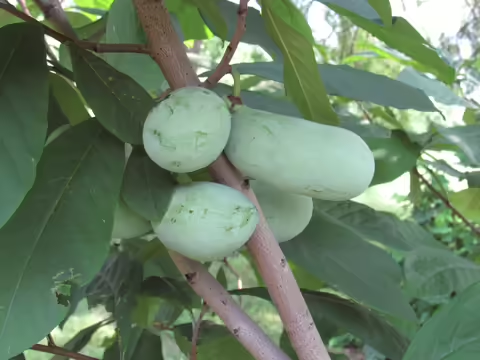It is almost pawpaw eating time! For those not already in the know, you too could soon have the opportunity to try your first delicious pawpaw fruit. If you’ve never heard of pawpaw before, don’t know what the fruit or the tree look like, and are interested to hear what all the hullabaloo is about, read on!
The PawPaw Tree, Asimina triloba
Did you know that pawpaw, Asimina triloba, is the largest native tree fruit of the United States? The photo to the right, taken at the Refuge Food Forest in Normal just last week.
The leaves are quite large, slightly shiny, or waxy, and if you have the right tree, you will notice that the leaf margins, or edges, are completely smooth.
If in the woods you find a mature tree or two, you’ll generally find a whole colony of them. This is because uncollected pawpaw fruit seeds will sprout small saplings nearby during the following spring.
Harvesting pawpaw fruit
When pawpaw fruit is ripe, it will drop to the ground; generally speaking, if the pawpaw is picked off the tree, the picker will be cutting short some of the sugar accumulation of the fruit. Collect pawpaws when they drop and leave them on your counter for a day or two before eating them. They produce ethylene gas, which assists with self-ripening! You’ll know when they’re ready when you smell a sweet, almost-fermented scent.
Eating pawpaws
The flavor of pawpaws has been described as a combination of an apple, a banana, and a mango. Unfortunately, their shelf life is short, which is why you don’t see them at grocery stores!
The best way to eat a pawpaw is to cut it in half the long way and scoop out the pulp with a spoon. Avoiding eating the skin or seeds, both are not safe to ingest.
Save the seeds to plant your own pawpaws by refrigerating them all in wet paper towels in winter, and plant them in spring!
How to find pawpaws
Take a walk in the woods, identify a pawpaw grove, and check up on them during early to late August. If you have one in your neighborhood, ask your neighbor nicely if you can try one. Pawpaw plants are available commercially at certain nurseries, but very popular, so good luck and order early!
ABOUT THE AUTHOR: Nick Frillman is a Local Foods and Small Farms Educator serving Livingston, McLean & Woodford counties. A fourth-generation graduate from University of Illinois, Frillman has a B.A. with a double major of Political Science and Spanish and a M.S. in Crop Science with a focus on crop production. Before joining Illinois Extension, Frillman completed a field season of CSA and farmers’ market style production at a small “beyond-organic” vegetable farm in Sandy, Ore.
